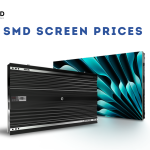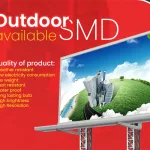SMD Screens and Touch Technology: The Seamless Integration
In today’s rapidly evolving digital landscape, the demand for advanced and immersive visual experiences is on the rise. The seamless integration of Surface-Mount Device (SMD) screens and touch technology has emerged as a game-changer in the world of display technology. This informative article delves into the realm of SMD screens and touch technology, examining their symbiotic relationship and unravelling the benefits they bring to various industries. By shedding light on the technical intricacies and the significant advancements paving the way, this article aims to enlighten readers about the incredible potential and seamless synergy of SMD screens and touch technology. Prepare to be captivated by the future of visual interaction and communication, where boundaries dissolve and possibilities unfold.
Table of Contents
- SMD Screens: Revolutionizing Display Technology
- Advancements in Touch Technology: Enhancing User Experience
- Seamless Integration of SMD Screens and Touch Technology: Benefits and Considerations
- Recommendations for Optimizing SMD Screens and Touch Technology Integration
- Q&A
- Key Takeaways
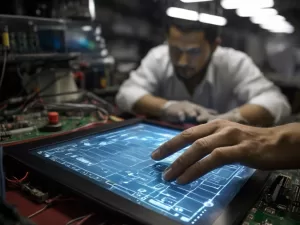
SMD Screens: Revolutionizing Display Technology
SMD screens have undoubtedly transformed the world of display technology, bringing with them a seamless integration of touch technology. These screens, using Surface Mount Device (SMD) technology, have revolutionized the way we interact with digital content, whether it be in our smartphones, tablets, or even large-scale electronic billboards.
One of the key advantages of SMD screens is their ability to provide a high level of visual clarity and resolution. With their advanced display technology, SMD screens deliver vibrant colors, sharp images, and enhanced contrast ratios, ensuring a truly immersive viewing experience. Whether you’re scrolling through your favorite social media feed or watching a high-definition video, the SMD screen provides stunning visuals that captivate and engage the user.
Moreover, the seamless integration of touch technology into SMD screens takes the user experience to the next level. Gone are the days of physical buttons and cumbersome interfaces – with SMD screens, a simple touch is all it takes to navigate through menus, browse websites, or play games. The responsiveness and accuracy of the touch sensors ensure that every interaction is effortless and intuitive. Additionally, the smooth touch interface of SMD screens allows for multi-touch gestures, enabling users to pinch, zoom, and swipe with ease.
In conclusion, SMD screens have brought about a revolution in display technology, seamlessly integrating touch capabilities into our everyday devices. With their exceptional visual clarity and immersive experience, these screens have set new benchmarks for display quality. The seamless touch integration only enhances this experience, making our interactions with digital content seamless and effortless. Whether it’s for personal use or commercial applications, SMD screens have become the go-to choice for those seeking top-notch display technology.

Advancements in Touch Technology: Enhancing User Experience
The seamless integration of SMD screens and touch technology has revolutionized the user experience, allowing for unprecedented levels of interactivity and responsiveness. With advancements in touch technology, such as capacitive touchscreens, SMD screens have become the go-to choice for applications that require smooth and precise touch input.
One of the key advantages of SMD screens is their ability to accurately detect multiple touch points simultaneously. This multi-touch capability opens up a whole new world of possibilities for users, enabling them to pinch, zoom, swipe, and perform other complex gestures with ease. Whether it’s navigating through a map, editing a photo, or playing a game, the seamless integration of SMD screens and touch technology ensures a seamless and intuitive user experience.
Furthermore, SMD screens offer exceptional image quality and clarity, thanks to their high-resolution displays. This translates into sharper text, vibrant colors, and lifelike visuals that provide an immersive viewing experience. Combined with the precise touch sensitivity, SMD screens deliver a seamless and intuitive interface that enhances user engagement and satisfaction.
In conclusion, the seamless integration of SMD screens and touch technology has significantly improved the user experience by offering accurate multi-touch capabilities and stunning image quality. Whether it’s for smartphones, tablets, or interactive displays, the seamless combination of SMD screens and touch technology is undoubtedly a game-changer in the world of user interface design. With further advancements on the horizon, we can expect even more enhancements in touch technology, making the user experience more seamless and immersive than ever before.
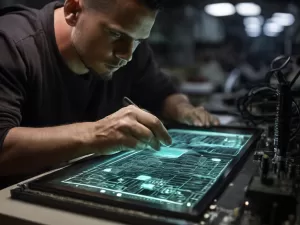
Seamless Integration of SMD Screens and Touch Technology: Benefits and Considerations
With today’s increasingly digital world, the seamless integration of SMD screens and touch technology has become a game-changer in various industries. These advanced displays offer numerous benefits, enhancing user experiences and transforming how we interact with technology.
One major benefit is the improved visual quality that SMD screens provide. These screens utilize Surface Mount Device (SMD) technology, which allows for higher pixel density, resulting in sharper images, vibrant colors, and better overall visual performance. This enhanced visual experience benefits industries such as advertising, retail, and entertainment, where captivating displays are crucial for grabbing and retaining audience attention. Additionally, SMD screens are designed to be durable, which means they can withstand various environmental conditions, making them suitable for installations in outdoor or high-traffic areas.
When it comes to touch technology, the integration with SMD screens takes user interaction to a whole new level. Touchscreens enable users to directly interact with digital content, eliminating the need for physical buttons or remotes. With touch-friendly interfaces, users can easily navigate through menus, zoom in and out, and interact with content in a highly intuitive manner. This intuitive interaction not only enhances user experience but also increases efficiency in tasks such as product selection, information retrieval, or interactive presentations. Whether it’s public kiosks, interactive displays, or educational environments, the incorporation of touch technology into SMD screens opens up possibilities for more engaging and interactive experiences.
In conclusion, the seamless integration of SMD screens and touch technology offers remarkable benefits across various industries. From improved visual quality to intuitive user interaction, these advancements have the potential to revolutionize how we interact with technology and engage with digital content. Whether you are in advertising, retail, or any industry that values captivating displays and intuitive user interfaces, exploring the possibilities of SMD screens and touch technology can greatly enhance your business strategies and customer experiences.
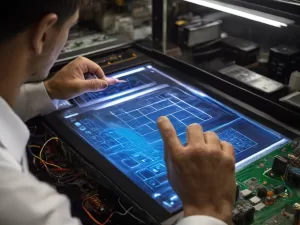
Recommendations for Optimizing SMD Screens and Touch Technology Integration
In order to optimize SMD screens and seamlessly integrate touch technology, there are several recommendations that can be followed. Firstly, it is essential to choose high-quality and reliable SMD screens and touch panels from reputable manufacturers. These components should be durable, responsive, and capable of delivering excellent image quality.
To ensure optimal performance, it is important to properly calibrate and calibrate the touch technology. This can be achieved by following the manufacturer’s instructions and utilizing any provided calibration software. Calibration helps to improve accuracy and responsiveness, resulting in a better user experience.
Another key factor in optimizing SMD screens and touch technology integration is thorough testing. It is essential to test the functionality and performance of the touch screens and touch panels before installation, as well as during regular maintenance. Testing should include checks for touch sensitivity, responsiveness, and any potential issues such as dead zones or erratic behavior.
When integrating touch technology, it is crucial to consider the design and layout of the system. Proper placement and mounting of the touch panels is important to ensure ease of use and accessibility. It is also important to consider the environment in which the screens will be used, such as lighting conditions and potential interference from other electronic devices.
In addition to hardware considerations, optimizing SMD screens and touch technology integration also involves software optimization. This includes selecting the appropriate drivers and firmware for the touch panels and ensuring they are compatible with the operating system being used. Regular software updates should be applied to keep the system up to date and secure.
In summary, optimizing SMD screens and seamlessly integrating touch technology requires careful consideration of hardware and software components, calibration and testing, as well as thoughtful design and layout. By following these recommendations, businesses can ensure a seamless and optimized user experience when utilizing SMD screens with touch technology.
Q&A
Q: What is SMD technology, and how does it relate to screen technology?
A: SMD technology, short for Surface Mount Display technology, refers to the method of fabricating and assembling electronic components directly onto the surface of a substrate material. In the context of screens, SMD technology is commonly used to produce highly efficient and compact LED screens.
Q: What are the benefits of SMD screens?
A: SMD screens offer a range of benefits, including superior image quality, high contrast ratios, and excellent color reproduction. By utilizing LED technology, SMD screens consume less power compared to traditional display technologies, making them energy-efficient. SMD screens are also highly durable, ensuring longevity and cost-effectiveness.
Q: How does touch technology integrate with SMD screens?
A: Touch technology complements SMD screens by adding an interactive element that allows users to directly manipulate the screen using touch gestures. Capacitive touch technology is most commonly integrated into SMD screens, enabling precise and responsive touch control. This integration expands the practicality of SMD screens, making them suitable for a wide range of applications, including smartphones, tablets, ATMs, and interactive displays.
Q: Can SMD screens be used for outdoor applications?
A: Yes, SMD screens are designed to be suitable for both indoor and outdoor installations. With advancements in technology, outdoor SMD screens now offer high brightness levels, ensuring optimal visibility even in direct sunlight. Additionally, these screens are built to withstand harsh weather conditions, making them suitable for various outdoor settings, such as advertising billboards and sports arenas.
Q: Are SMD screens expensive compared to other screen technologies?
A: While SMD screens may initially seem costlier than some traditional display technologies, their long-term benefits outweigh the initial investment. Due to their efficient energy consumption, SMD screens can save considerable costs in terms of electricity bills. Moreover, their durability and resistance to damage reduce the need for frequent maintenance or replacement, further lowering overall costs.
Q: Is it possible to create large-scale displays using SMD screens?
A: Yes, SMD screens are highly versatile and can be seamlessly integrated to create large-scale displays. Through modular designs, SMD screens can be easily connected and configured to form expansive video walls or digital signage. This capability allows businesses, event organizers, and advertisers to showcase dynamic content across larger areas while maintaining a high-quality visual experience.
Q: Is it challenging to maintain and repair SMD screens?
A: SMD screens are designed with user-friendliness and ease of maintenance in mind. With the advances in technology, many SMD screens come with built-in diagnostic systems that make it easier to troubleshoot and identify any potential issues. Additionally, as these screens are often assembled with individual modules, repairing or replacing faulty components becomes a less cumbersome and cost-effective process.
Q: Are there any notable limitations of SMD screens?
A: While SMD screens offer numerous advantages, there are a few limitations worth considering. SMD screens may be susceptible to the so-called “screen door effect,” where the small gaps between individual pixels become noticeable, particularly at close distances. However, this effect is usually less pronounced at normal viewing distances. Additionally, SMD screens may require an appropriate cooling system to prevent excessive heat buildup during extended operation.
Q: What is the future outlook for SMD screens and touch technology integration?
A: The integration of SMD screens with touch technology is expected to continue evolving rapidly. Advancements in both fields will likely result in even slimmer displays, improved touch sensitivity, and enhanced visual quality. As touch-controlled devices become increasingly prevalent in our daily lives, the seamless integration of SMD screens and touch technology will be crucial for creating more immersive and engaging user experiences.
Key Takeaways
In conclusion, the integration of SMD screens and touch technology marks a significant milestone in the realm of seamless user interaction. The advanced capabilities of SMD screens, coupled with the intuitive touch technology, have revolutionized the way we interact with digital devices. From smartphones to tablets, and even large-scale displays, this integration has paved the way for a more immersive and efficient user experience.
The seamless integration of SMD screens and touch technology offers numerous benefits, including enhanced responsiveness, superior image quality, and improved durability. With the capacitive touch technology enabling precise and multi-touch gestures, users can effortlessly navigate through menus, zoom in and out of images, and interact with content in a natural and intuitive manner.
Moreover, the ultra-thin form factor of SMD screens ensures a sleek and seamless design, making them ideal for a wide range of applications. Whether in consumer electronics, automotive displays, or digital signage, this integration caters to various industries’ needs, providing a versatile solution that can be seamlessly incorporated into different devices and environments.
As technology continues to evolve, the seamless integration of SMD screens and touch technology will continue to be at the forefront of innovation. This symbiotic relationship between hardware and software engineering lays the groundwork for future advancements, offering limitless possibilities for a more interconnected and interactive world.
In conclusion, the integration of SMD screens and touch technology heralds a new era of user experience, ushering in a future where efficiency and interactivity converge seamlessly. As the demand for more intuitive and immersive interfaces increases, this integration will undoubtedly shape the landscape of digital interaction in the years to come, propelling us into a world where technology fades seamlessly into the fabric of our daily lives.
Contact Us For Free Consultation at 0306-1333384
Powered By BIACommunication



